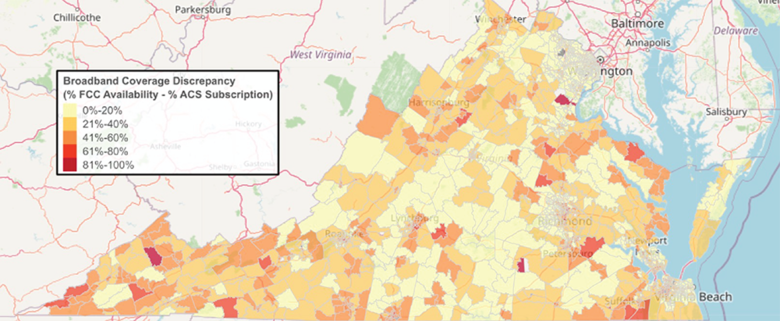We are examining federal loan and grant programs that facilitate broadband deployment to otherwise ‘off-the-grid’ areas, and explore whether access to and use of broadband, median household income, and residential home values increased over time in communities that received broadband access as a result of these programs. We use a number of diverse data sources to accomplish our goal. These include:
- Local real-estate tax assessment and deed data to identify property characteristics and sales values;
- Federal Communications Commission (FCC) data to map broadband coverage;
- US Department of Agriculture Rural Utilities Service (RUS) program data to identify where programs have been deployed; and
- American Community Survey (ACS) data to describe the demographic, economics, and social characteristics of eligible areas that received a RUS grant compared to those that did not.
Our early findings highlight how best to leverage existing federal and private-sector data to study broadband availability in rural communities and the effects of having or not having broadband access. Our continued work includes:
- Examining divergences in data quality (such as broadband coverage reported between ACS and FCC (see Figure 1).;
- Comparing social, demographic, and economic characteristics of areas that received Rural Utilities Service(RUS) grants or loans with eligible areas that did not receive such assistance;
- Examining areas that received RUS grants or loans with areas immediately surrounding the grant area (e.g., 5 miles out, 25 miles out as a concentric circle around the area) to assess if there are spillover benefits; and
- Using spatial modeling techniques to examine changes in residential property values before and after program implementation.
Figures

Distinguished Professor in Biocomplexity, Biocomplexity Institute
Professor of Public Health Sciences, School of Medicine
McDonald S, Sawhney R, Savchyn K, Pristavec T, Goldstein J, Shipp S. (2020) Broadband Coverage in the US: When Sources Disagree, Data Science for the Public Good 2019: US Broadband Coverage Discrepancy Map, MethodSpace, Sage Publishing.





